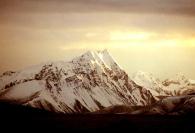
| The Qinghai-Tibet Plateau is surrounded by large mountain ranges. To the east and southeast the plateau gives way to the forested gorge and ridge geography of the mountainous headwaters of the Salween, Mekong, and Yangtze rivers in the Hengduan Mountains in western Sichuan and southwest Qinghai. In the west it is embraced by the curve of the rugged Karakoram range of northern Kashmir. Near the south the plateau is transected by the Yarlung Tsangpo River (upper Bramaputra) valley which flows along the base of the Himalayas. |
The plateau is bordered to the Kunlun Range which separates it from the Tarim Basin, and to the northeast by the Qilian Range which separates the plateau from the Hexi Corridor and Gobi Desert. The Qinghai-Tibet Plateau is bounded on the north by a broad escarpment where the altitude drops from over 12,000 feet to 3,000-5,000 feet in less than 100 miles. Along the escarpment is a range of mountains. In the west the Kunlun Mountains separate the plateau from the Tarim Basin. About half way across the Tarim the bounding range becomes the Altyn-Tagh and the Kunluns, by convention, continue somewhat to the south. In the “V” formed by this split is the western part of the Qaidam Basin. The Altyn-Tagh ends near the Dangjin pass on the Dunhuang-Golmud road. To the west are short ranges called the Danghe, Yema, Shule and Tulai Nanshans. The easternmost range is the Qilian Mountains. The line of mountains continues east of the plateau as the Qinling Mountains which separate the Ordos Region from Sichuan. North of the mountains runs the Gansu or Hexi Corridor. It was the main silk-road route from China to the west in the past.
The Qinghai-Tibet Plateau is a high-altitude arid steppe interspersed with mountain ranges and large brackish lakes. Annual precipitation ranges from 100 mm to 300 mm and falls mainly as hailstorms. The southern and eastern edges of the steppe have grasslands which can sustainably support populations of nomadic herdsmen, although frost occurs for six months of the year. Permafrost occurs over extensive parts of the plateau. Proceeding to the north and northwest, the plateau becomes progressively higher, colder and drier, until reaching the remote Changthang region in the northwestern part of the plateau. Here the average altitude exceeds 5,000 meters (16,500 feet) and year-round temperatures average ?4 °C, dipping to ?40 °C in winter. As a result of this extremely inhospitable environment, the Changthang region, together with the adjoining Kekexili region is the least populous region in Asia and the third least populous area in the world after Antarctica and northern Greenland.
|